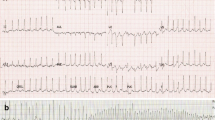Summary
The antiarrhythmic properties of adenosine, its ultrashort half-life and the absence of frequent serious side effects make it a front-line agent in arrhythmia management, especially in the treatment of atrioventricular nodal reentrant tachycardia. Due to a shortening of atrial refractoriness, adenosine can facilitate the induction of atrial fibrillation. Life threatening tachycardias may result from a potential rapid conduction of atrial fibrillation over an accessory pathway especially if the latter one has a short antegrade refractory period.¶ We report a case of a 59 year old female patient in which intravenous administration of adenosine during typical atrioventricular nodal reentrant tachycardia was followed by atrial fibrillation with rapid conduction over a hitherto unknown accessory pathway.¶ After intravenous administration of adenosine the tachycardia was terminated successfully within 38s. After a short period of asystole, spontaneous atrial fibrillation developed unmasking an antegrade preexcitation with subsequent rapid ventricular response (210 b/min). The three-lead ECG showed a narrow QRS complex tachycardia. Because of spontaneous conversion to sinus rhythm and the absence of hemodynamic compromise there was no need for external cardioversion.¶ During electrophysiological study an antidromic atrioventricular reentrant tachycardia was recorded over a left posteroseptal accessory pathway including antegrade conduction properties only.¶ Because of its ultrashort half-life, serious side effects after adenosine administration are rare. The possibility of life threatening proarrhythmias after intravenous adenosine administration should be taken into consideration if the etiology of a paroxysmal supraventricular tachycardia is not clear and a concomitant Wolff-Parkinson-White syndrome cannot be excluded.¶ As with application of all intravenous antiarrhythmic agents, the administration of adenosine should only be performed if continuous ECG monitoring and cardioversion facilities are available and possible.
Zusammenfassung
Die antarrhythmischen Eigenschaften von Adenosin sowie seine Fähigkeit zur Terminierung vor allem atrio-ventrikulär-(AV)-nodaler Reentry-Tachykardien sind seit langem bekannt. Über eine Verkürzung der atrialen Aktionspotential-Dauer kann Adenosin das Auftreten von Vorhofflimmern begünstigen. Lebensbedrohliche, tachykarde Rhythmusstörungen können dann resultieren, wenn Vorhofflimmern über akzessorische Leitungsbahnen rasch auf die Kammern übergeleitet wird.¶ Wir berichten den Fall einer ¶59-jährigen Patientin bei welcher eine Adenosin-Gabe während einer typischen paroxysmalen AV-nodalen Reentry-Tachykardie zum Vorhofflimmern mit rascher Überleitung auf die Ventrikel über ein bis dahin unbekanntes akzessorisches Leitungsbündel führte.¶ Aufgrund der extrem kurzen Halbwertszeit von nur wenigen Sekunden sind schwerwiegende unerwünschte Wirkungen nach Adenosingabe äußerst selten. Die Möglichkeit des Auftretens lebensbedrohlicher proarrhythmischer Effekte nach parenteraler Adenosinapplikation sollte vor allem dann bedacht werden, wenn die Ätiologie einer paroxysmalen supraventrikulären Tachykardie nicht bekannt ist und ein konkomitierend vorliegendes Wolff-Parkinson-White-Syndrom nicht sicher ausgeschlossen werden kann.
Similar content being viewed by others
Author information
Authors and Affiliations
Additional information
Eingegangen: 8. Dezember 1999/Akzeptiert: 9. Februar 2000
Rights and permissions
About this article
Cite this article
Drescher, S., Bosch, R.F., Mewis, C. et al. Adenosingabe zur Terminierung einer atrio-ventrikulär-nodalen-Reentry- Tachykardie: Induktion von Vorhofflimmern mit schneller Überleitung bei Demaskierung eines konkomitierenden Wolff-Parkinson-White-Syndroms. Z Kardiol 89, 522–526 (2000). https://doi.org/10.1007/s003920070224
Issue Date:
DOI: https://doi.org/10.1007/s003920070224




